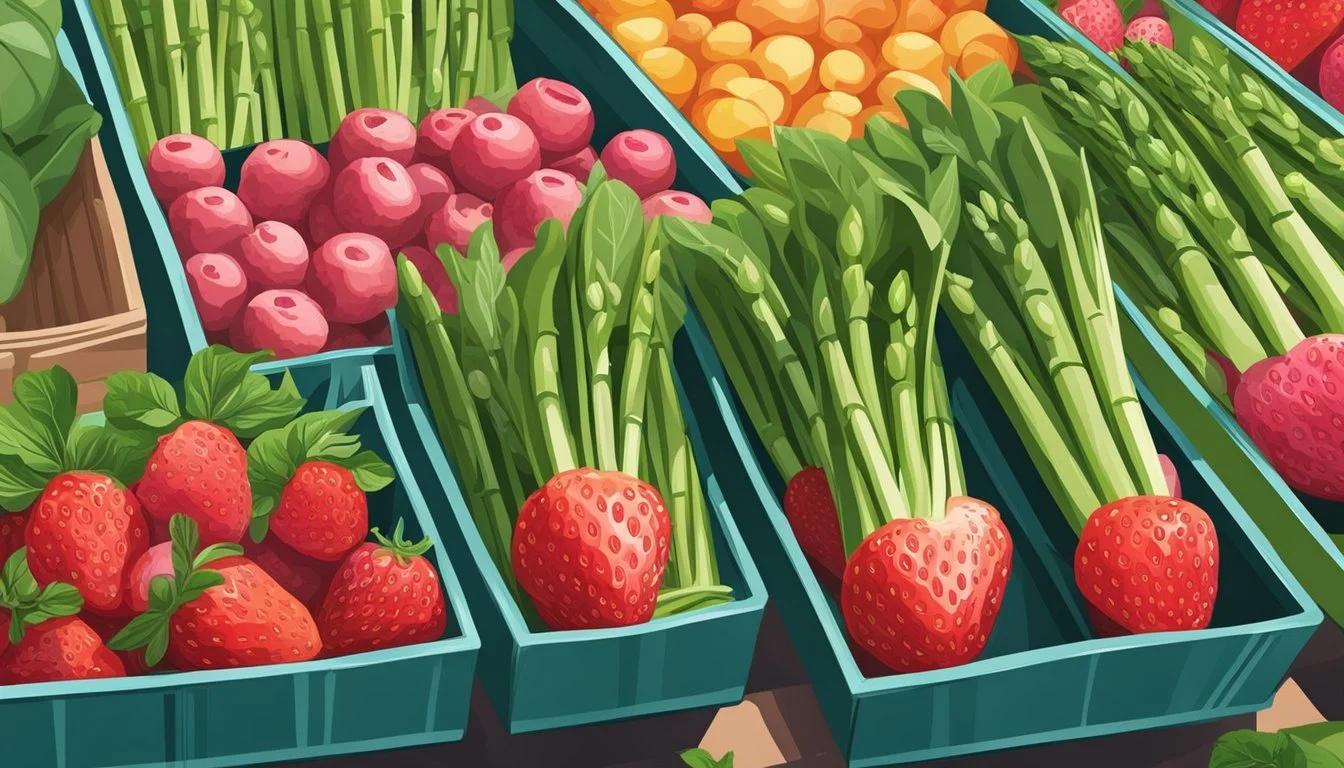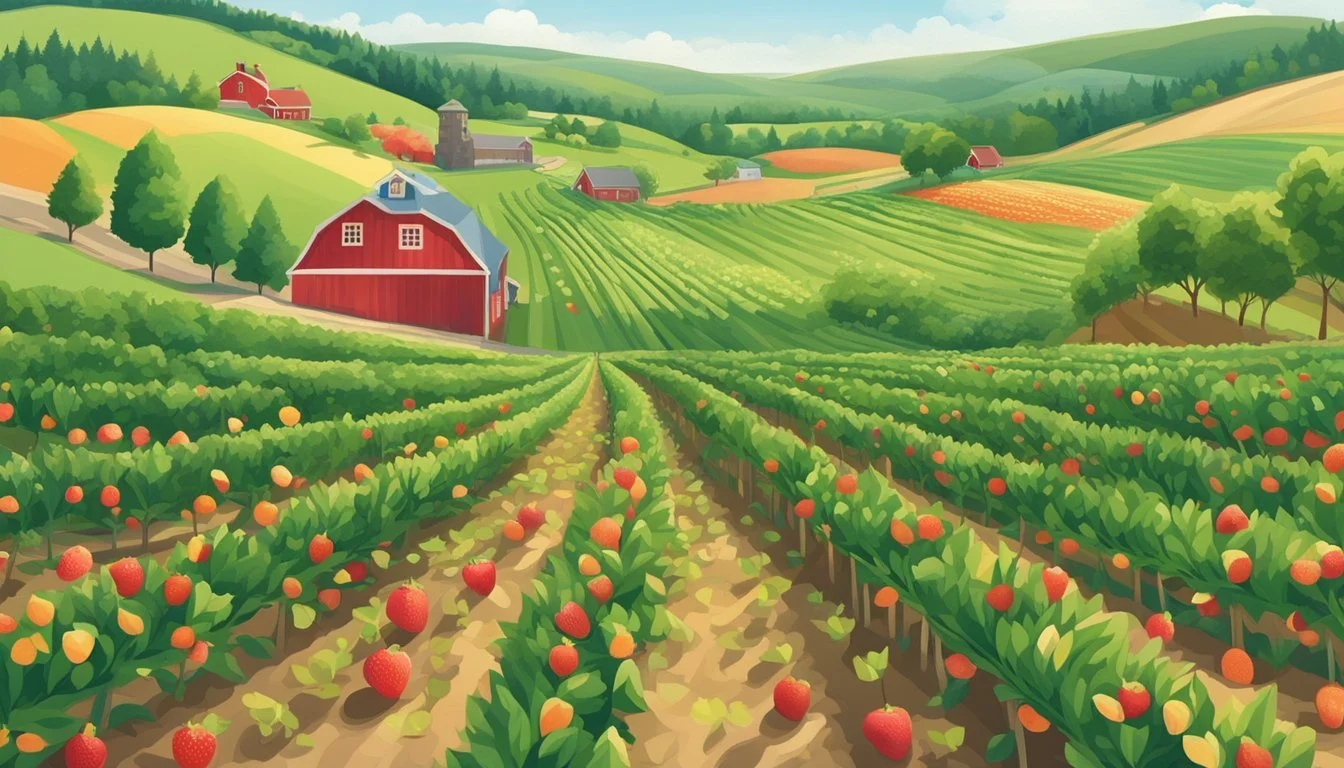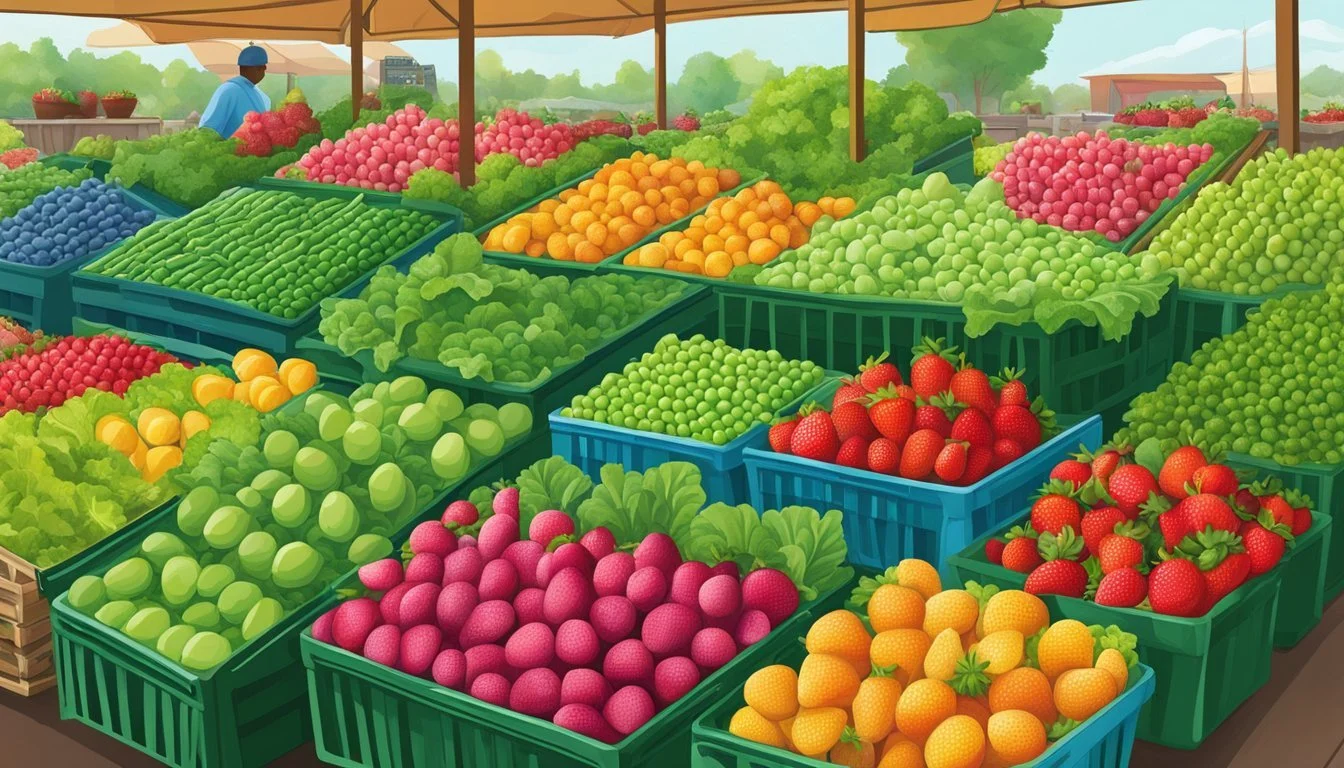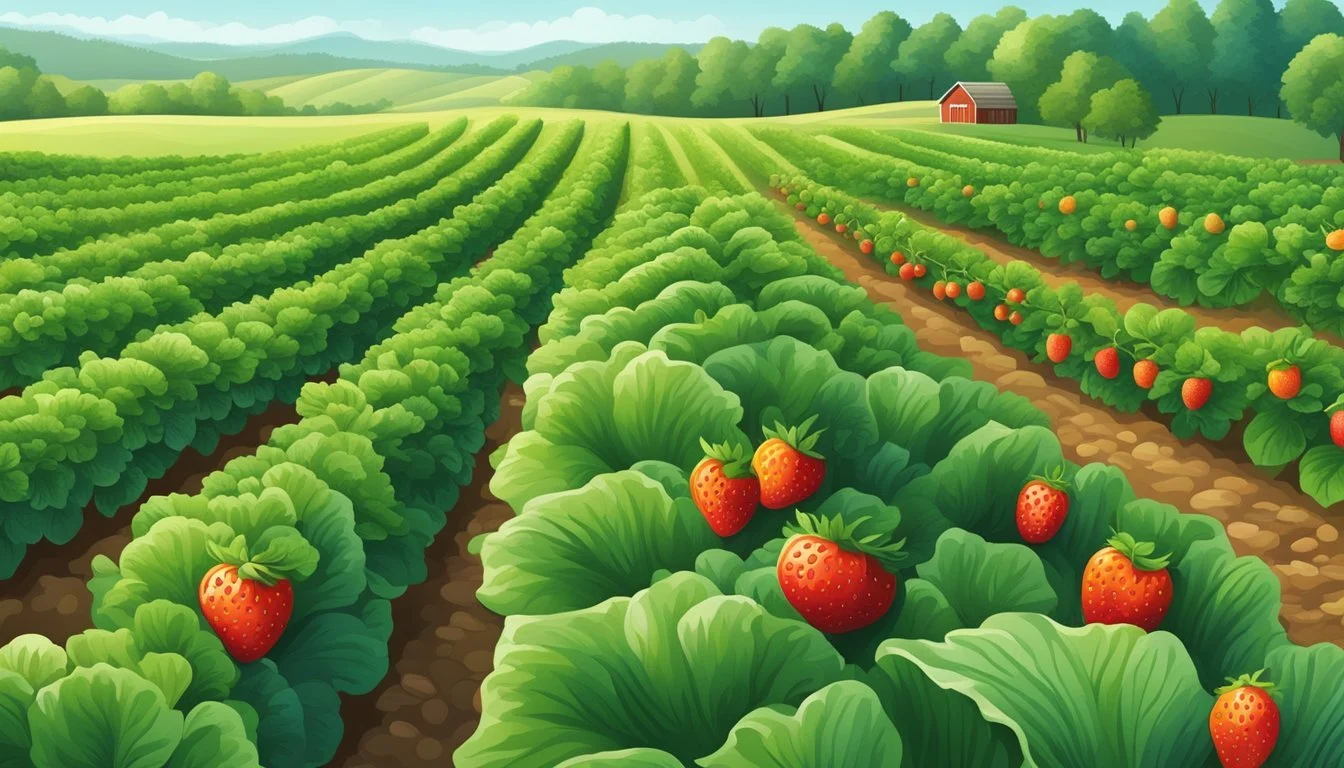Kansas Seasonal Fruit & Vegetables in May
A Fresh Produce Guide
This Article is Part of our Kansas Seasonal Fruit & Veg Calendar
As spring reaches its peak in Kansas, the state's agricultural tapestry begins to burgeon with an array of fresh produce. May marks a transitional period in the region's farming calendar, welcoming the early harvest of several fruits and vegetables. The state's rich soil and increasing day lengths foster the growth of a selection of crops that are not only flavorful but also integral to the local cuisine and economy.
Among the produce available, certain fruits and vegetables flourish in the May climate, providing residents and chefs with ingredients at their freshest and most nutritious. Seasonal eating not only supports the local farming community but also promises a dining experience that highlights the natural cycles of growth and harvest in Kansas. The distinct flavors of freshly-picked produce offer an authentic taste of the state, as local markets and roadside stands brim with a variety of seasonal offerings.
Understanding Kansas' Growing Season
In Kansas, the growing season is marked by a transition from the cooler temperatures of spring into the warmth of the summer. This period is significant for agriculture and dictates the availability of various fruits and vegetables.
Seasonal Overview
Kansas enjoys a versatile growing season, accommodating a wide spectrum of fruits and vegetables. The state's climate is classified as continental, which means Kansas experiences extreme temperature variations with cold winters and hot summers. These conditions influence the planting and harvesting timelines for local produce, making seasonality key for fresher and more flavorful crops.
May in Kansas
May signifies a time when Kansas' fields become increasingly verdant, signaling the presence of certain ready-to-harvest crops. With the average last frost date in late April or early May, growers can safely plant a variety of produce. Fresh offerings in May typically include:
Vegetables:
Arugula
Asparagus (how long does asparagus last?)
Beets
Broccoli
Cabbage
Lettuce
Radishes
Salad greens
Spinach
Fruits:
Strawberries begin to ripen towards the end of May
Farmers are busy during this time as they prepare for the upcoming peak growing months.
Kansas State University Agricultural Insights
Kansas State University (K-State) remains an invaluable resource for local growers, providing research and recommendations tailored to the state’s unique agricultural challenges. K-State's insights into seasonal planting including the use of cover crops and techniques like raised bed gardening help optimize production. By leveraging university extension programs, farmers in Kansas can stay abreast of the best practices for May planting and beyond, ensuring a robust growing season.
Fruits and Vegetables in Season for May
In Kansas during May, residents can enjoy a fresh and flavorful array of fruits and vegetables harvested at their peak. This is the time when tender vegetables and the early fruits make their seasonal debut.
Fruits
May in Kansas marks the arrival of several fruits that are both nutritious and delicious. The following are ripe for picking:
Strawberries: Their vibrant red hues and juicy sweetness are characteristic of May harvests.
Cherries: Both tart and sweet varieties of cherries start to become available towards the later part of the month.
Vegetables
As for vegetables, May sees a variety of garden-fresh produce. Kansas soil yields:
Asparagus: This nutrient-dense spear is typically at its prime early in the month.
Onions: Fresh onions start to be pulled from the ground, offering crisp flavors.
Radishes: Characterized by their peppery taste, radishes are perfect for adding a crunch to salads.
Beans: A variety of beans begin to emerge, good for a multitude of dishes.
Cucumbers: Known for their cool and refreshing taste, cucumbers start to become available.
Selecting Quality Produce
When shopping for fresh produce in May in Kansas, consumers should focus on the condition of the fruits and vegetables to ensure maximum flavor and longevity of their purchases. Determining ripeness and employing effective storage methods are crucial for enjoying the season's offerings.
Assessing Ripeness
Asparagus: Stalks should be upright and firm to the touch. The tips must be tight and compact. Larger diameter spears are not necessarily tougher; it's a variety characteristic.
Lettuce, Spinach, and Other Salad Greens: Leaves should look crisp and vibrant without any wilting or discoloration. Freshness is indicated by a gentle, yet firm texture.
Radishes: They should have brightly colored roots and firm, unblemished skin. Leaves must be green and fresh, not wilted.
Scallions (Green Onions): Choose ones with crisp, green tops and a bright white base.
Strawberries: Look for bright red berries, fully ripe with a natural sheen and a vibrant green cap.
Storage Tips
Asparagus: Store upright in a glass with water at the bottom or wrap the ends in a damp paper towel and place in the refrigerator.
Lettuce, Spinach, and Salad Greens: Wrap in a dry paper towel and store in a plastic bag in the crisper drawer of the refrigerator.
Radishes: Remove the tops and store in a plastic bag in the refrigerator. They can be kept in water for crispness.
Scallions: Place in a plastic bag in the crisper drawer of the refrigerator. They can also be stored in water on the counter for short-term use.
Strawberries: Do not wash until ready to eat. Store in the refrigerator in a container that allows air circulation.
Consumers find the best selection and freshness at local farmers' markets, which can be a direct pipeline from the farm to the table. It's often recommended to shop early to get the best selection of size and taste profiles for all produce.
Kansas Produce Preparation
Kansas offers a rich variety of produce in May, providing ample opportunity for fresh and healthy meals. Proper preparation can enhance the natural flavors and ensure food safety.
Simple Recipes
When preparing Kansas produce such as asparagus, lettuce, and spinach, one can enjoy their fresh flavors with minimal effort. Simple recipes that highlight the quality of the May harvest include:
Asparagus: Lightly steamed and drizzled with olive oil, topped with a sprinkle of sea salt (how long does sea salt last?) and lemon zest (how long does lemon zest last?).
Salad Greens: Tossed in a homemade vinaigrette with fresh, chopped herbs like parsley and chives (how long do chives last?) for a refreshing and healthy side dish.
Spinach: Sautéed with garlic and a touch of nutmeg (how long does nutmeg last?), making for a delicious and nutritional addition to any meal.
Preservation Techniques
To extend the shelf-life of the seasonal bounty, various preservation techniques can be employed:
Asparagus and Radishes: Can be pickled in a vinegar solution and stored in jars, retaining their crunchiness and flavor.
Strawberries and Apples: Suitable for making jam, canning is an excellent method to preserve their sweetness and enjoy year-round.
It is crucial to follow proper canning guidelines to maintain food safety.
Where to Find Local Produce
In Kansas, the month of May offers a variety of fresh, locally grown produce. To obtain these seasonal goods, consumers should explore farmers markets or participate in Community Supported Agriculture programs.
Farmers Markets
Farmers markets in Kansas are bustling hubs providing access to a plethora of fresh fruits and vegetables directly from regional growers. The Kansas Department of Agriculture maintains a comprehensive listing of farmers markets across the state, ensuring consumers can locate the nearest market with ease. Shoppers often find the likes of fresh asparagus, lettuce, radishes, and more during May. Here are a few notable markets:
Overland Park Farmers Market: Renowned for a wide variety of local produce.
Wichita Farmers Market: Offers a mix of seasonal goods in the heart of the city.
Lawrence Farmers Market: Features locally grown products and artisan foods.
Community Supported Agriculture (CSA)
CSA programs are a direct partnership between consumers and farmers, where consumers receive regular deliveries or pick-ups of seasonal produce. Joining a CSA in Kansas connects consumers with their food source and supports local agriculture. Participants not only get a share of the harvest but also the unique experience of understanding the seasonal cycle of their food. Some established CSAs in Kansas include:
Rolling Prairie CSA: A cooperative of several farms providing diverse selections.
Juniper Hill Farms CSA: Known for sustainable practices and a broad variety of produce.
Common Harvest CSA: Committed to organic methods and providing seasonal favorites.
Benefits of Eating Seasonally
Eating seasonally offers a range of advantages, particularly when one focuses on fresh, local Kansas produce. Seasonal fruits and vegetables are harvested at the peak of their ripeness, which not only improves flavor but also ensures the highest nutritional value. These crops have naturally developed their full spectrum of vitamins, minerals, and antioxidants.
Cost-Effectiveness: Seasonal produce is often more affordable. Local farmers save on transportation and storage costs, making seasonal goods less expensive for consumers.
Environmental Impact: Seasonal eating supports sustainable farming practices. It reduces the carbon footprint associated with long-distance transport and encourages biodiversity.
In terms of health benefits, eating fruits and vegetables that are in season corresponds with the body's nutritional needs for that time of year. For instance, winter crops might be higher in immune-boosting vitamins to combat cold weather, while summer selections could provide hydration and electrolytes.
Moreover, purchasing from local Kansas farmers ensures that fruits and vegetables are fresh, as they have spent less time in transit and more time ripening naturally. This not only supports the local economy but also encourages a closer connection to the source of one’s food.
Season Kansas Produce Example Nutritional Highlight Spring Asparagus High in Fiber Summer Tomatoes Rich in Lycopene Fall Apples Good source of Vitamin C Winter Squash Contains Vitamin A
Embracing this cycle of consumption helps individuals align with nature's offerings and maintain a diet that is diverse, nutrient-dense, and attuned to the rhythms of the local environment.
Home Gardening Tips
For Kansas residents, May is a pivotal month for planting a variety of vegetables that can thrive in the local climate. With careful planning and execution, one can transform their garden into a bountiful source of fresh produce.
Starting a Garden
When initiating a garden, it is essential to select a suitable location that receives ample sunlight and has good soil quality. A soil test, which can be facilitated by K-State Research and Extension, will provide valuable information about soil fertility and pH levels, guiding the amendment process to create an optimal growing environment. Proper spacing between plants can prevent overcrowding and reduce the risk of disease.
Basic Requirements for Starting a Garden in Kansas:
Location: Choose a spot that receives at least six hours of sunlight daily.
Soil Testing: Engage K-State Research and Extension for a comprehensive soil analysis.
Soil Preparation: Amend the soil based on test results, incorporating organic matter if needed.
Plant Selection: Pick plants suited to the Kansas climate and the specific conditions of your garden.
Spacing: Follow recommended spacing guidelines to ensure healthy plant growth.
Seasonal Planting Guide
In May, Kansas gardeners should focus on planting vegetables that can withstand the state's unpredictable spring weather. Certain cool-season crops like lettuce can handle occasional frost and even a light snow cover, making them ideal choices for this time of the year.
Recommended Vegetables to Plant in May:
Lettuce: Varieties such as Butterhead, Boston, and Loose Leaf are cold hardy and low maintenance.
Broccoli: Best planted in early May for a harvest from June to October.
Carrots: Plant now for a crop that lasts through November.
Brussels Sprouts: While typically planted later, starting seeds indoors can prepare them for an August through November harvest.
Gardeners should refer to the K-State Research and Extension's comprehensive planting guides for specific varieties best suited to local conditions. They should also consider the space requirements for fruits and vegetables, planning accordingly to maximize their garden’s potential.









